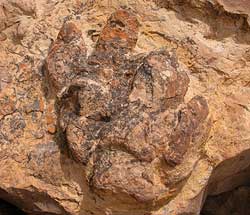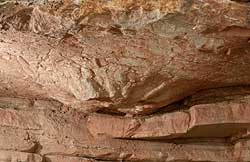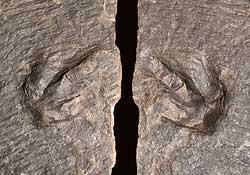Dinosaur Facts |
Fossil Formation |
Dinosaur Tracks |
Dinosaur State Park |
Johnson Farm Track Site |

Dinosaur Tracks

|
|
Two large tracks found near Parowan, Utah.
|

|
|
Brontosaurus track bulge.
|

|
| Dinosaur track (left) and cast (right). |
Introduction
Dinosaur tracks are fossils known as trace fossils. Trace fossils are geological evidences that record biological activity. These can include burrows, feeding marks, footprints, etc. This is different from body fossils like dinosaur bones. Instead of physical evidence from the bones of the animal it is evidence taken from the environment in which the animal lived. The study of these trace fossils is called ichnology. Specific trace fossils associated with dinosaurs include their footprints, and marks from their tails, snouts, bellies, and trackways made from their feet or tails.History
Dinosaur tracks were probably known anciently to human beings. We know this is true of Native Americans due to some petroglyphs and names given near dinosaur track sites. However, it is doubtful that the ancient ancestors knew the nature of these tracks, as it wasn't until the mid-late 1800s that the connection between dinosaurs and their tracts was made. Several finds were made in the early 1800s including a major find of several fossil tracks in Connecticut. However, these finds were mistaken as being laid by prehistoric birds of some kind. It wasn't until later that these discoveries were determined to be dinosaur tracks. Since that early period, dinosaur tracks have been neglected by paleontologists as mildly interesting. Only in recent years, since approximately the 1980s, have dinosaur tracks gained popularity. This has been encouraged by the discovery of many new track sites like that of St. George, Utah, and the publishing of many books on the subject. Currently the examination continues actively as a major division of dinosaur study.How are they Formed?
The general process of fossilization for dinosaur tracks is an complex process. Several factors have to be present. First of all the dinosaur must make a track in an environment where tracks are easily formed such as soft wet ground found around lakes, rivers, and swamps, etc. After these impressions are left, they usually are filled in by another sediment. It helps if this sediment is of a different material then the sediment the track was made in, therefore it won't mix and the track will remain preserved. Once the track is filled a cast is made. Over time either the original track or the cast or both become sedimentary rock. Sometimes the original track will erode away leaving only the cast and what appears to be an inverted dinosaur track. Sometimes a bulge is made in a underlining layer beneath the actual track. Whatever the case may be these tracks are later uncovered, usually through erosion and discovered today.Where are they Found?
In order for a dinosaur track to form it is usually necessary for the dinosaur to step in moist environments but this is not always the case. There have been some discoveries of dinosaur tracks from what used to be ancient dry regions but these discoveries are rare. Sometimes a dinosaur makes an impression in local foliage and this is compressed over time and turned to coal deposits with the foot imprint still visible. However, the most common method of track formation is in ancient mud or moist ground. These are found in what used to be wetlands or swamps, as wells as coast lines and dried up rivers and lakes. These tracks are then preserved and today over 1000 track sites have been discovered all over the world. In the United States most tracks are found in the southern and western states, with a few eastern state exceptions such as tracks found in Connecticut, Massachusetts, and New Jersey.What do we Learn?
There are many things that we can learn from the study of Dinosaur tracks and trace fossils. They can give us some idea of the size of the dinosaur. By analyzing the positioning of the tracks and the space between them we can get a good idea of the dinosaur's gait and speed. The tracks tell us a lot about the locomotion of the dinosaur, for instance, whether or not it walked on two legs or four. We can learn more about its behavior be studying its posture while it stood or while it moved. Other clues to its posture can be seen in the tracks left be its tail, if any exist. Many impressions are made in ancient foliage which later fossilized to form coal, giving us an idea of the environments the dinosaur walked in. Many sites have been found with numerous tracks from several dinosaurs giving us information on the social behavior of the dinosaur, whether they traveled in packs or not. In addition to all of this we can learn of its foot anatomy and foot padding. Even though we can learn a lot from dinosaur footprints it is often difficult to determine which dinosaur left the footprints, unless a skeleton of the dinosaur is buried nearby.
ScienceViews Writer: Jason Hamilton.
Copyright © 2005-2010 Calvin & Rosanna Hamilton. All rights reserved.